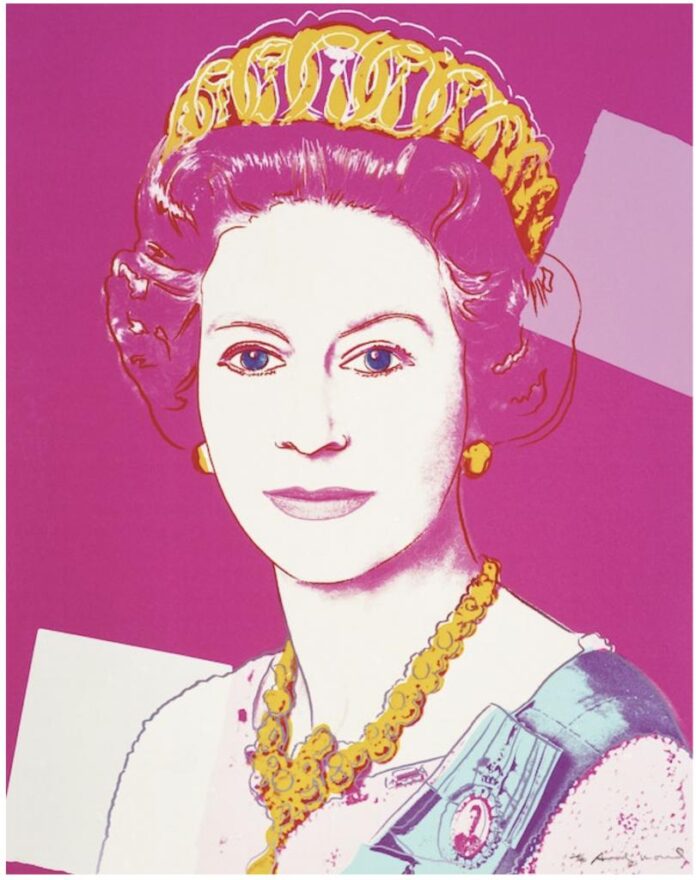This Thursday, June 8, Toronto’s Cowley Abbott auction house will present the first of a two-session sale, “Important Canadian and International Art” (4 p.m. EDT). Comprising 100 works—by artists ranging from David Bowie to Marc Chagall—the sale will feature an incredible range of significant 20th- and 21st-century art.
A highlight of the sale includes the presentation of a suite of prints from Andy Warhol’s iconic “Reigning Queens” series, which hails from the Winnipeg Art Gallery (WAG) – Qaumajuq collection. The deaccession and sale of this work will contribute to fundraising for the gallery’s endowment, specifically to support the acquisition and representation of diverse art and artists—specifically contemporary Indigenous artworks—in the permanent collection. Cowley Abbott too will be donating their commission from this sale to the WAG – Qaumajuq endowment development.
Below, we’ve rounded up the sale’s not-to-be-missed top lots.
Andy Warhol
, from “Reigning Queens” (1985; F&S II.334–337)
Est. $700,000–$900,000

Andy Warhol, Queen Elizabeth II of the United Kingdom, from “Reigning Queens” (1985). Courtesy of Cowley Abbott, Toronto.
The undisputed king of Pop art, American artist Andy Warhol (1928–1987) garnered particular renown for his images of famous people—from Marilyn Monroe to Queen Elizabeth II, as seen in the present lot. Warhol’s 1985 “Reigning Queens” portfolio is comprised of sixteen portraits of four ruling queens (four portraits each). The composition of the Queen Elizabeth II image is based on the queen’s official 1977 Silver Jubilee photo by Peter Grugeon. The artist’s removal of fine details and inclusion of monochromatic swaths of color reduces the queen from an individual to a symbol of royal power.
Fernando Botero
(1994)
Est. $350,000–$450,000

Fernando Botero, (1994). Courtesy of Cowley Abbott, Toronto.
Columbian figurative artist Fernando Botero (b. 1932) has a unique artistic language marked by its experimentation with proportions—both in his painting and sculpture—and distinctive sense of tactility and sensuality. These facets of Botero’s style are immediately recognizable in (1994), where the central figure is seemingly dwarfed by their surroundings, conveying a sense of the uncanny, as well as offering a modern interpretation of the still life tradition. The rounded linework and vivid color palette together offer viewers a visual space to interpret or project their own experience with the composition.
Emily Carr
(ca. 1928)
Est. $1,000,000–$1,500,000

Emily Carr, (ca. 1928). Courtesy of Cowley Abbott, Toronto.
Canadian artist and writer Emily Carr (1871–1945) is perhaps best known for her paintings depicting Indigenous peoples and cultures as well as landscapes of the Pacific Northwest. Carr’s paintings were considered avant-garde, as she favored the styles of the Modernists and Post-impressionists. The present work, (ca. 1928) came from a multi-year endeavor of the artist to be granted passage to the village of Kitwancool, famed for its totem poles.
Lawren Stewart Harris
(ca. 1926–28)
Est. $2,000,000–$3,000,000

Lawren Harris, (ca. 1926–28). Courtesy of Crowley Abbott, Toronto.
Like Carr, Lawren Stewart Harris (1885–1970) was a Canadian artist working mainly in the early 20th century. An important figure in the landscape painter’s Group of Seven—also known as the Algonquin School—Harris helped modernize and popularize the Canadian art scene. Harris often returned to sites of previous landscape paintings but subtly changed his nuanced color schemes, and altering the perspective to accomplish something new in each work. The result is a cohesive yet still varied body of work.
Jean Paul Riopelle
(1953)
Est. $500,000–$700,000

Jean Paul Riopelle, (1953). Courtesy of Cowley Abbott, Toronto.
Leading Canadian Abstract Expressionist Jean-Paul Riopelle (1923–2002) was classically trained at the École des Beaux-Arts and early in his career associated with Les Automatistes, an avant-garde art group based in Quebec. Les Automatistes were inspired by the Surrealists and held an aversion to the art establishment. In the late 1950s, however, Riopelle met American Abstract Expressionist Joan Mitchell, following which Riopelle’s style evolved into a concretely abstract style. The present untitled lot is from early in his engagement with AbEx, and illustrates the artist’s experimentation with color, brushstroke, and pure abstraction.
Joan Miró
(1951)
Est. $70,000–$90,000

Joan Miró, (1951). Courtesy of Cowley Abbott, Toronto.
Surrealist multidisciplinary artist Joan Miró (1893–1983) had an artistic practice focused on revolutionizing painting. His work is purposefully difficult to categorize, as his form of mark-making and composition were aimed at disrupting traditional modes of art. One of the artist’s largest series was a succession of hastily drawn works that all bear the title , completed in the early 1950s. The lines and shapes that appear in these works are references to compositions Miró had completed previously but simplified and streamlined to only the absolute essential elements.

























